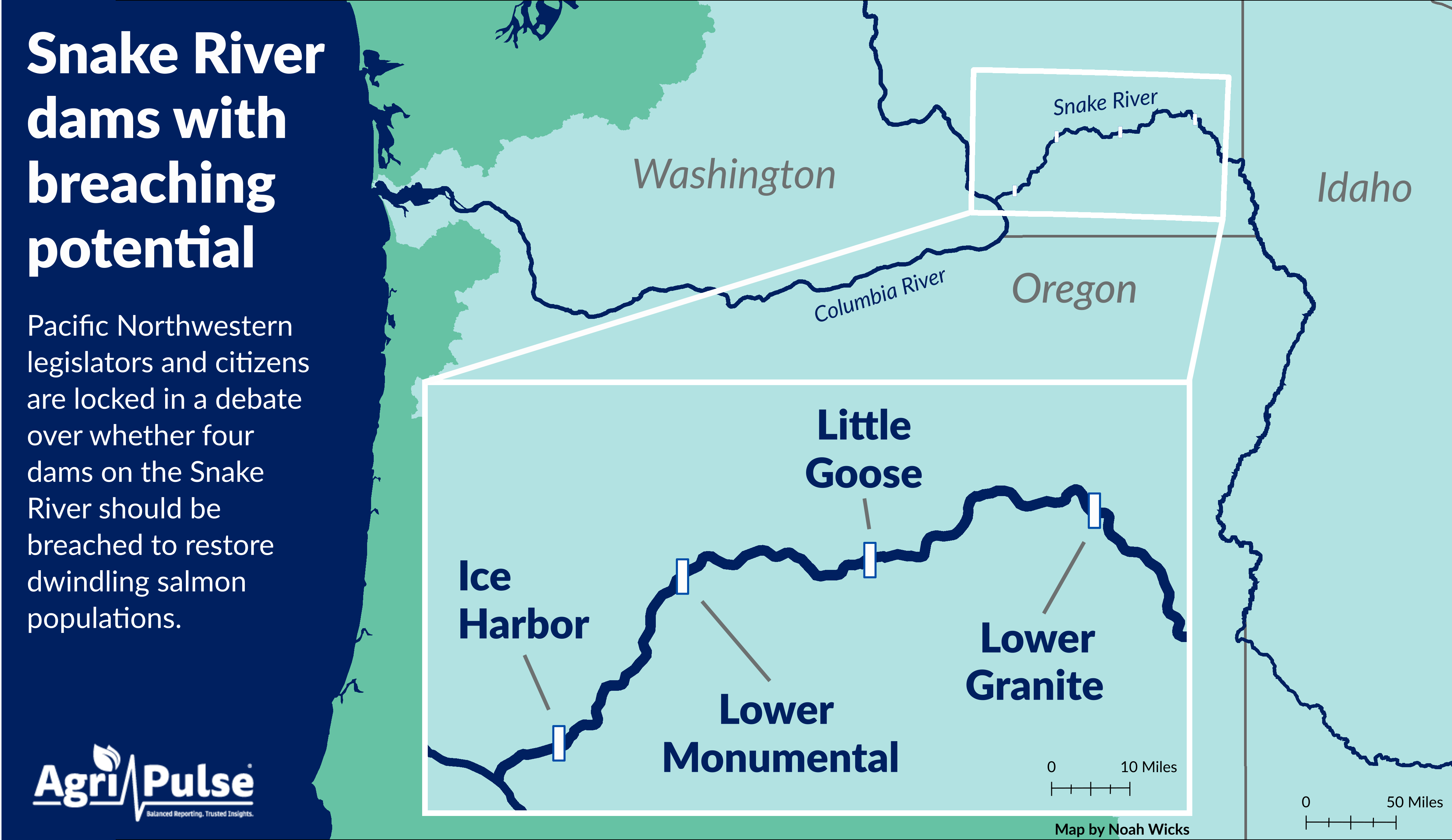The National Marine Fisheries Service says removal of four dams on the Snake River is “essential” to bringing the river’s imperiled salmon populations back to harvestable levels. The Bonneville Power Administration believes replacing the lost power is possible, but would cost between $11 and $19 billion.
Those are the conclusions of two draft reports released by the agencies on Tuesday. Though the White House's Council on Environmental Quality, which announced the reports' release, said the same day it was not endorsing breaching, some critics of the reports said that is precisely the administration's goal. In any case, the findings will help lay a foundation for the Biden Administration's plan to restore salmon populations in the river and settle a decades-long legal dispute over the operation of the dams.
“These two reports add to the picture — that we are working alongside regional leaders to develop — of what it will take over the decades ahead to restore salmon populations, honor our commitments to Tribal Nations, deliver clean power, and meet the many needs of stakeholders across the region,” Council on Environmental Quality Chair Brenda Mallory said in a statement.
State wildlife agencies in Oregon and Washington estimate that salmon runs in the Columbia and Snake River have shrunk by more than 90% in the last century. Some tribes, environmentalists, and fishermen have brought the issue to court, suing the agencies in charge of operating the dams for not doing enough to curb the decline.
A federal judge recently halted proceedings to allow both sides to engage in “good faith discussions” on how to resolve the salmon issue, giving them until July 31 to iron out an agreement. Biden administration officials, pressured to find a solution the other parties will agree on before the judge takes matters into his own hands, have recently emphasized the need for drastic change in how the river is managed.
“The question about what the Biden administration will actually do is still open,” Todd True, an Earthjustice attorney representing environmental groups in the case, told Agri-Pulse. “Certainly they have talked about changing directions, charting a new course, taking a comprehensive approach, all good things to say. The proof is in the pudding and what they do — and we don't have that answer yet.”

But Tuesday’s reports are likely to stoke an already tense fight over the fate of the four dams and the impact their removal would have on communities throughout the region. Farmers, irrigators, utility companies and power users have voiced opposition to removing the dams, worried that doing so will harm their livelihoods and the economy of the region.
Nicole Berg, the president of the National Association of Wheat Growers, said in a statement Tuesday that the loss of barging would have “devastating economic impacts” on producers across the United States. Approximately 10 percent of the nation’s wheat exports travel up the river by barge.
“NAWG has serious concerns about these reports and encourages the administration to engage with the agricultural industry because breaching these dams will adversely impact wheat growers who are already facing economic pressures from inflation and lingering supply chain issues," she said.
Don’t miss a beat! It’s easy to sign up for a FREE month of Agri-Pulse news! For the latest on what’s happening in Washington, D.C. and around the country in agriculture, just click here.
A group of Republican legislators, whose ranks include Washington Reps. Dan Newhouse, Cathy McMorris Rodgers and Jaime Herrera Butler, along with Idaho Rep. Russ Fulcher and Oregon Rep. Cliff Bentz, echoed those concerns. In a joint statement, they accused CEQ of "working behind closed doors” with plaintiffs in the lawsuit.
“Today’s release of two reports from the Biden administration’s Council on Environmental Quality confirms what we have suspected for some time — they are cherry-picking points to justify breaching the Lower Snake River Dams, which will permanently and negatively impact our way of life in the Pacific Northwest,” the legislators said.
The Biden administration, while tasked with maintaining and operating the dams, has its hands tied when it comes to removal. Federal agencies have the authority to maintain the dams for navigation, hydropower, recreation and water supply uses. Breaching them, however, would require an act of Congress.
So far, Mike Simpson, R-Idaho, and Earl Blumenauer, D-Ore., have been the only legislators to officially support removal of the dams, introducing a $33.5 billion “concept” to do so. The proposal would compensate people in the region for their losses and put a 35-year moratorium on all current litigation.
Other legislators have been hesitant to leap into the fray, though Sen. Patty Murray has teamed up with Washington Governor Jay Inslee, a fellow Democrat, to come up with a state-federal plan for salmon recovery in the basin. They released an initial draft of a report looking at the issue last month, which they are now revising based on public comments.
For more news, go to www.agri-pulse.com.


